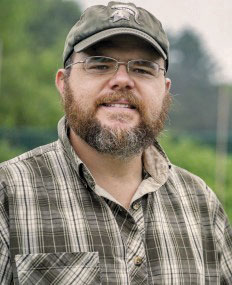GenNext Resarchers: Matthew J. Grieshop
As the next generation of growers become leaders and decision makers in their own operations, they won’t have to make those decisions on their own. There’s also a whole new generation of experts focused on the research needed to combat today’s (and tomorrow’s) challenges in the field and the orchard.
We talked with some of these researchers about the problems they’re attempting to solve, the new tools they’re using, and how they hope their work will help you do your job better.
 
Matthew J. Grieshop
Associate Professor of Organic Pest Management and Clarksville Research Center Faculty Coordinator |
Primary area of research
Development of pest management practices that are compatible with the National Organic Program. A great deal of my lab’s projects are focused on biological control or the use of cultural pest management tactics — i.e. orchard floor management. We have an increasing number of projects that are focused on the development of new pesticide delivery platforms, in particular, solid set canopy delivery systems for trellised tree fruit, and attract-and-kill systems for fruits and vegetables.
What specific projects are you working on now?
My research team is:
■ Developing and testing solid set canopy delivery system prototypes for high-density apple plantings
■ Developing and testing a semiochemical-based attract-and-kill system for codling moth, Oriental fruit moth, Japanese beetle, spotted wing drosophila, and the brown marmorated stink bug
■ Evaluating baseline biological control of the brown marmorated stink bug and identifying likely predators and parasitoids, and
■ Evaluating raking, cultivation, and nitrogen-input-based tactics for apple scab management.
Are you bringing any new technology, tools, or approaches to your research that might be new to these types of programs?
My lab has developed a number of different digital video surveillance systems for studying insect behavior in the field. We use these systems for evaluating attract-and-kill devices and insect traps, as well as identifying predators of important insect pests.
Most recently, members of my research team have been looking into using PCR and next-generation sequencing to identify predators of key insect species, as well as how floor management and nutrient inputs affect the detritivore community on orchard floors.
As the next generation of growers become leaders on their farms, what will they need to do differently to continue to be successful? How do you see your research work helping them accomplish that?
I think the specialty crop growers of today and tomorrow are tasked with two interrelated pest management challenges/opportunities.
The first is, as much as possible, the development of biological solutions to pest management problems. This should be done by building cropping systems that are naturally resistant or at least tolerant of pest pressure and require minimal pesticide inputs.
The second is a total redesign of pesticide delivery systems which allow us to carefully control pesticide residuals on developing or finished products. My research program addresses both of these points through the exploration of biological and cultural pest management practices, as well as the development of new pesticide delivery systems.
How long have you been doing research in support of fruit and vegetable growers?
I have been working in pest management research since 1994. My career began as an undergraduate research assistant working in apples, cotton, strawberries and artichokes in central California. Between 1996 and 2005 I shifted gears and worked on biological management of rangeland weeds, wheat pests and stored product insects. In 2005 I began working in mating disruption with the WA apple industry and in 2007 I took a job with Michigan State University as the Organic Pest Management Specialist. Since 2007 I have worked on pest management projects in apples, cherries, blueberries, asparagus and greenhouse vegetables and bedding plants. Most of my work has focused on insect pests but I have also performed research on weed and plant pathogen management.
What made you want to get into ag research as a profession?
From an early age I was always interested in agriculture as, in my mind, it represents the biggest interface between humans and nature — everybody eats! My parents maintained a medium sized vegetable garden and I spent many afternoons hunting down tomato horn worms and other veggie pests for my mother. As a teenager I joined my high school’s FFA program where I grew greenhouse vegetables and California oak trees for a reforestation project. As an undergraduate at the University of California at Santa Cruz (UCSC) I had the fortune to get involved in pest management research at that school’s organic farm and eventually on surrounding farms. My experiences at UCSC fueled my interest in agriculture and provided me with my ultimate career goal —to help growers produce profitable and high quality crops with a minimal environmental footprint through the use of biological and ecological principals.












